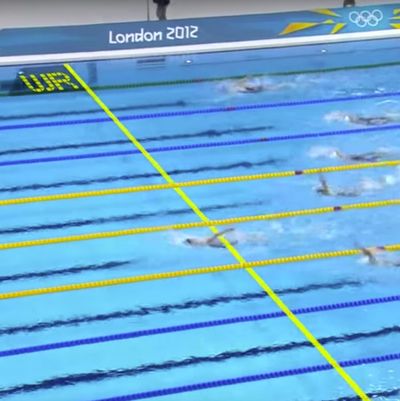
At the 2012 London Games, Missy Franklin was such a favorite coming into the 200-meter backstroke final that “The Star-Spangled Banner” could have started playing before she even got into the pool. She swam the fastest time in the prelims, won her semifinal race, and, as NBC swimming commentator Rowdy Gaines put it during the first 50 meters of the final, “her backstroke has looked spectacular this entire competition.”
It didn’t take Franklin long to pull away from the field. With around 75 meters to go, she was ahead by a full body length. And when she made her final turn to swim the last 50 meters of the race, it was over. At least her race against the other swimmers was.
As Franklin swam the final length of the pool, a gold medal already in her grasp, she still had one more opponent — the yellow line swimming alongside her and atop her, showing TV audiences exactly how fast she needed to go to break the world record.
The final length of the pool was a one-on-one race pitting a 17-year-old woman against 12-year-old virtual projection. With 25 meters to go, the line was at her ankles. With 15 it had reached her knees. Five meters from the finish, the yellow line was at Franklin’s waist. And then she touched the wall. The line got there .75 seconds later, and the next racer was more than a full second later than that. In person, the race was a blowout. But on TV it was a dramatic dash to the wall as Franklin pursued history, and it was all made possible by that thin yellow line.
The virtual world-record line, which moves at a constant pace based on the world-record split, made its Olympic debut in Sydney. At those same Games, a gawky 15-year-old from Baltimore swam his first Olympic race. Sixteen years later, Michael Phelps is in Rio as the most decorated Olympian of all time. But it’s not hard to argue that even with all of Phelps’s accomplishments, the world-record line was the best thing to come out of the Sydney Games.
Long after Phelps has retired, the world-record line will be in the pool. Or, more accurately, it will look to those watching TV as if it’s in the pool. And like it always has, the line will add suspense to Olympic races that lack them. Or another layer of drama to races where swimmers are fighting for first place. That’s the brilliance of the world-record line. It’s always there, spicing up the blowouts, making the competitive races tense, and, when the winner is lagging far behind it, giving permission for those of us on our couches to shake our heads in disgust.
The line’s already left its mark in Rio. On Sunday night, Katie Ledecky destroyed her own world record in the 400-meter freestyle, pulling away from the yellow line as the race ended. It was the same story the night before when Hungary’s Katinka Hosszú obliterated the world record in the 400-meter individual medley. Watching the vaunted world-record line lagging behind in those two races made the swimmers’ accomplishments even more impressive and dramatic to those of us watching at home.
“Anything that helps the audience better understand and process what’s happening during competition quickly moves from ‘Great innovation’ to ‘How did we ever watch this without it?’ Swimming has especially benefited from innovations like lane identifications, underwater cameras, and the world-record line,” NBC Olympics executive producer Jim Bell told me.
He’s right. The old way of tracking a swimmer’s world-record pace — waiting for the splits every 50 meters — belongs in the era of tube TVs. In those days, if a swimmer made her final turn and was a tenth of a second on either side of the record, it was impossible to know where she stood until the race was over.
The line is, quite obviously, better than that, and it even has the Emmy to prove it. Just a few months after the Sydney Olympics, the company that partnered with NBC to make the line possible, Orad Hi Tec Systems, won a winged woman. Former NBC Sports & Olympics chairman Dick Ebersol said at the time, “We knew that the action from the swimming venue was going to be terrific in Sydney and the viewing experience was significantly enhanced by … the world record line.”
It did the same in Athens, Beijing, London, and now Rio. And it will continue to make swimming more watchable, even when Phelps, Franklin, and Ledecky are long gone. And unlike those swimmers, who will eventually slow down, the world-record line just keeps getting faster.





























